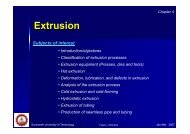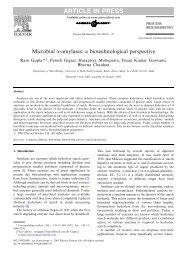Protein engineering from a bioindustrial point of view
Protein engineering from a bioindustrial point of view
Protein engineering from a bioindustrial point of view
You also want an ePaper? Increase the reach of your titles
YUMPU automatically turns print PDFs into web optimized ePapers that Google loves.
420 <strong>Protein</strong> <strong>engineering</strong><br />
[32]. Some progress in designing variants that reduce<br />
this inhibition by creating favorable surfactant-enzyme<br />
interactions have been reported to give improved laundry<br />
performance [49].<br />
Callulase and xylanase<br />
Cellulases have become increasingly important in recent<br />
years because <strong>of</strong> their ability to provide the s<strong>of</strong>t feel<br />
<strong>of</strong> stone washed jeans in textile processing, and fabric<br />
care benefits (such as color crispness) when used in a<br />
laundry detergent [SO]. Most commercial cellulases are<br />
endoglucanases (promoting internal bond hydrolysis) and<br />
contain a catalytic functional region and a cellulose-<br />
binding domain (CBD) connected by a linker region.<br />
Since cellulases have very poor activity against insoluble<br />
cellulose without the binding domain, significant effort<br />
has gone into understanding the adsorption and activity<br />
relationship [Sl]. It is noteworthy that in this work better<br />
activity was correlated with stronger adsorption, in contrast<br />
to the studies mentioned earlier on proteases [31]. A<br />
recent paper reported the free energies <strong>of</strong> binding <strong>of</strong> two<br />
different CBDs and a fusion protein <strong>of</strong> the two. The<br />
double CBD was found to bind much more tightly than<br />
the separate domains [52]. A study <strong>of</strong> the role <strong>of</strong> Tyr169 in<br />
the Trihodmna reesei cellobiohydrolase II catalytic domain<br />
suggests that it plays an important role in distorting the<br />
glucose ring into a more reactive conformation [53’].<br />
Xylanases are used in the pulp and paper industry to<br />
reduce the quantity <strong>of</strong> chemicals required for bleaching,<br />
and thereby provide an environmentally preferred route<br />
to pulp processing [54]. A good re<strong>view</strong> <strong>of</strong> the different<br />
families <strong>of</strong> xylanases and their structure and activity is<br />
presented in a recent article [W] in Current Opinion<br />
in Biotechno/ogy. In an important mechanistic study <strong>of</strong><br />
a xylanase <strong>from</strong> B. circulans, Lawson et a/. [56*] varied<br />
the distance between the two catalytically active carboxyl<br />
groups at the active site. They found the native distance<br />
was optimum, but the fall <strong>of</strong>f in activity was more<br />
rapidly when the distance was increased than when it was<br />
shortened.<br />
Conclusion<br />
It is clear that protein <strong>engineering</strong> has played a central<br />
role in improving commercially important enzymes and<br />
in finding new applications <strong>of</strong> proteins quite different<br />
<strong>from</strong> their natural function. From an industrial perspective,<br />
being able to rapidly identify such an enzyme is also<br />
very important. Recent successes in the directed evolution<br />
approach suggest it may be more efficient than rational<br />
design. The possibility <strong>of</strong> bypassing the laborious task<br />
<strong>of</strong> understanding the relationship(s) between protein<br />
function and the envisioned application, as well as<br />
sidestepping the difficult questions <strong>of</strong> how structure<br />
and function are related, strengthens this perception.<br />
Perhaps experience will teach that devising representative<br />
high-throughput screens <strong>of</strong> the final application will be just<br />
as difficult as the rational design <strong>of</strong> functional materials.<br />
Meanwhile, many industries are looking carefully at the<br />
directed evolution approach. Structure determination and<br />
structure-function studies will continue to be essential<br />
because most industrial problems are solved by a combi-<br />
nation <strong>of</strong> approaches. Additionally, such information is the<br />
source <strong>of</strong> ideas for new opportunities.<br />
An understanding <strong>of</strong> the relationship between basic<br />
properties and structure is far <strong>from</strong> complete. Never-<br />
theless, improving protein thermostability is becoming<br />
relatively routine. This is because earlier investigations<br />
have identified a number <strong>of</strong> structural features influencing<br />
thermostability, so that mutations with a high probability<br />
<strong>of</strong> success are easy to identify and to test. Improving<br />
enzyme activity is more difficult, since the structural pa-<br />
rameters affecting activity are not as clearly defined. This<br />
is particularly true where substrates are macromolecular<br />
and insoluble, as they are for many <strong>of</strong> the important<br />
industrial enzymes.<br />
In the last section I tried to focus on a few <strong>of</strong><br />
the most important classes <strong>of</strong> industrial enzymes and<br />
on important applications <strong>of</strong> each type. I hope it is<br />
clear that developing improved enzymes is challenging,<br />
requiring an understanding <strong>of</strong> structure, a knowledge <strong>of</strong><br />
structure-function relationships, and an appreciation <strong>of</strong> the<br />
mechanism <strong>of</strong> action responsible for good performance in<br />
the ultimate use. More importantly, I hope that this re<strong>view</strong><br />
illustrates that real progress is being made in improving<br />
commercially important enzymes.<br />
Acknowledgements<br />
I would like fo thank Phil Brode, Carolyn Burns, Rowan Grayling, Phil<br />
Green, Charlie Saunders and Sancai Xie, who <strong>of</strong>fered helpful comments on<br />
the manuscript.<br />
References and recommended reading<br />
Papers <strong>of</strong> particular interest, published within the annual period <strong>of</strong> re<strong>view</strong>,<br />
have been highlighted as:<br />
. <strong>of</strong> special interest<br />
� * <strong>of</strong> outstanding interest<br />
1. Frey W, Schief WR Jr, Pack DW, Chao-Tsen C, Chilkoti A, Stayton<br />
. P, Vogel V, Arnold F: Two-dimensional protein crystallization via<br />
metal-ion coodination by naturally occurring surface histidines.<br />
Proc Nat/ Aced Sci USA 1996, 9X4937-4941.<br />
The use <strong>of</strong> histidines to nucleate two-dimensional (2D) crystals extends the<br />
range <strong>of</strong> soluble proteins which may be crystallized in this manner. In addition<br />
to providing materials for structure determination by electron diffraction, 2D<br />
crystals can serve as seeds for exitaxial growth <strong>of</strong> three-dimensional crystals.<br />
Such crystals could also form the basic structures <strong>of</strong> biosensors.<br />
Dolder M, Engel A, Sulauf M: The micelle to vesicle transition <strong>of</strong><br />
lipids and detergents in the presence <strong>of</strong> a membrane protein:<br />
towards a rationale for 2D crystallization. FEBS Leti 1996,<br />
362:203-206.<br />
Sun Y-C, Veenstra DL, Kollman PA: Free energy calculations<br />
<strong>of</strong> the mutation <strong>of</strong> Ile + Ala in barnase: contributions to the<br />
difference in stability. <strong>Protein</strong> Eng 1996, 9:273-261.<br />
Elamrani S, Berry MB, Phillips GN Jr, McCammon JA: Study <strong>of</strong><br />
global motions in proteins by weighted masses molecular<br />
dynamics: adenylate kinase as a test case. <strong>Protein</strong>s 1996,<br />
25:79-86.<br />
Moult J: The current state <strong>of</strong> the art in protein structure<br />
prediction. Curr Opin Biotechnol 1996. 7~422-427.










